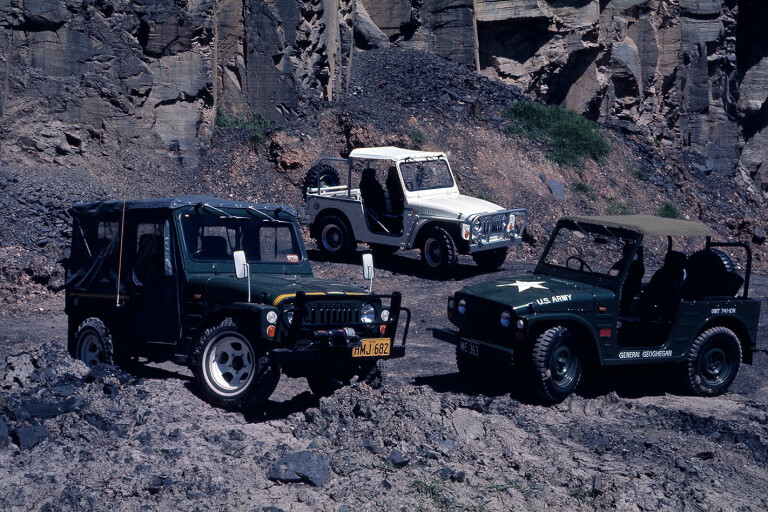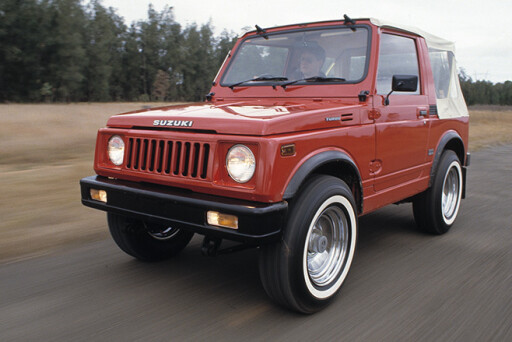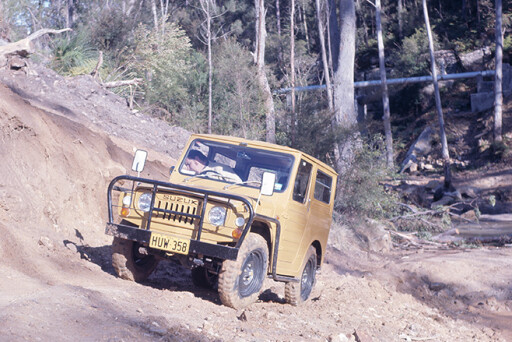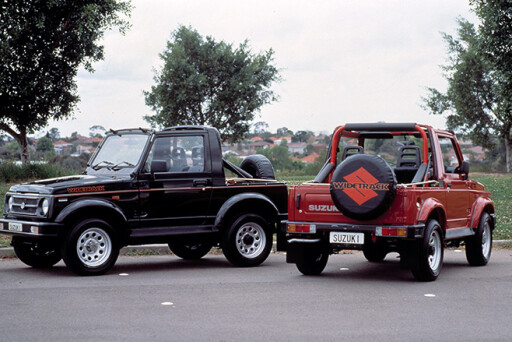
Article originally published in December 2014 issue of 4X4 Australia.
VERY few of today’s 4x4s can trace a direct line of ancestry back through history like the Suzuki Jimny Sierra. In much the same way a contemporary Jeep Wrangler is the direct descendant of the original Jeep ‘created’ by the US Army in World War II – and the current Land Rover Defender is the descendent of the original 1948 Land Rover – today’s Jimny Sierra is the latest incarnation of 45 years of Suzuki 4x4.
Suzuki’s history dates back to 1909, but back then the company didn’t manufacture cars, 4x4s or even motorcycles. When founded in 1909 by Michio Suzuki it was known as the ‘Suzuki Loom Works’ and it produced textile-spinning looms for Japan’s silk industry.

In 1937, Suzuki decided to expand into the auto industry. However, plans for its tiny 800cc car were shelved during World War II because the Japanese government declared civilian cars to be non-essential. Following the war Suzuki returned to producing textile machinery, but in 1951 it produced a motorised bicycle called the ‘Power Free’. By 1954 Suzuki was producing 6000 motorcycles per month and had officially changed its name to Suzuki Motor Co., Ltd. A year later it produced its first production car: the ‘Suzulight’.
Fast forward to 1968, when Suzuki bought the small Japanese car company Hope Motor Company, which had just introduced a tiny 4x4 called the HopeStar ON360. Suzuki re-engineered the HopeStar, including adding its own air-cooled 360cc twin-cylinder two-stroke engine, and launched what was called the LJ10 in 1970.
This was a very basic, open-top 4x4 with canvas doors and just three seats, as the spare sat inside the vehicle behind the driver. This was so the LJ10 wouldn’t exceed – for registration reasons – the external size restrictions for its class in Japan. The LJ10 weighed just 600kg and had a wheelbase of less than two metres. It was built on a separate chassis and featured leaf spring live axles, front and rear, as well as a part-time dual-range 4x4 system. Two years later the LJ10 was replaced with the LJ20, which brought with it a slight jump in power and water-cooling to its two-stroke engine.

In late 1975, following the success of the LJ10 and LJ20 on the domestic market, Suzuki decided to export the little 4x4, with an initial focus on Australia. To this end Suzuki repowered the LJ20 with a water-cooled 540cc three-cylinder two-stroke engine, and in doing so created the LJ50.
Available as a soft-top, canvas-door model or as a hard-top, metal-door model, the LJ50 was an instant success in Australia; both as a recreational 4x4 and as a farm vehicle. Even though the three-cylinder engine produced just 25kW and 57Nm, the LJ50’s light 635kg meant it had adequate performance and a top speed nearing 100km/h.
More significant was the fact that its light weight meant the Suzuki wasn’t fazed by soft surfaces such as sand and mud and, in its day, the mighty midget embarrassed many bigger, more powerful 4x4s.
The final iteration of the LJ series, the LJ80, arrived in Australia in 1978 and was powered by a 797cc four-cylinder four-stroke engine that claimed 31kW. This was a simple, single overhead cam, eight-valve carburettor engine. The body featured larger flared wheel arches and a higher bonnet line to accommodate the taller engine. The track was also widened, the final-drive gearing raised and the interior upgraded. A long-wheelbase ute version, designated the LJ81 and called the Stockman in Australia, was also introduced.
The second-gen model, called the Sierra in Australia but going under a variety of names around the world, arrived in Oz in July 1981. It came with a 970cc SOHC eight-valve four-cylinder four-stroke engine that claimed 39kW and was mated to a four-speed manual. It was available as a soft-top, hard-top or a long-wheelbase ute.

In 1984 a new 47kW 1324cc four-cylinder four-stroke engine, mated to a five-speed manual, was added to the range – the 970cc engine continued in the ute and cab-chassis variants. A soft-top built on the long wheelbase was also introduced in 1984 and a high-roof variant was subsequently introduced.
In 1991 the 1324cc engine made way for a new 1298cc engine that claimed 47kW – the 970cc engine and four-speed manual soldiered on in ute and cab-chassis models. This model line-up continued during the 90s with a short-wheelbase soft-top, a short-wheelbase hard-top, a long-wheelbase soft-top, a long-wheelbase ute and long-wheelbase cab-chassis versions. Given there were various state distributors for Suzuki in Australia at this time, different variants were available in different states.
In late 1996 the Sierra’s underpinnings were revamped with coil springs replacing leaf springs, although the live axles and separate chassis’ were retained. This brought about much-needed improvement to the Sierra’s on-road handling and general civility – though there’s still much debate as to whether the leaf springs or coil springs are better off-road.
In late 1998, the third-generation model, dubbed the Jimny and later referred to as the Jimny Sierra, arrived in Australia. The Jimny not only looked entirely different to its predecessor but was also longer, wider and, unlike the Sierra, only came in one body style. The Jimny featured a new engine, shift-on-the-fly 4x4 engagement and came with the option of a four-speed automatic. Underneath, however, it retained a separate chassis and coil-sprung front and rear live axles.

The new engine retained the 1298cc capacity of its predecessor but gained a 16-valve head and fuel injection for a 12kW power boost. It claimed 59kW and 104Nm. However, that engine was short-lived and in October 2000 a new 1328cc engine with double overhead cams arrived. This only bumped the claimed peak power up by 1kW (to 60kW) but the peak torque increased to 110Nm. It also offered more low-rpm torque, better fuel efficiency and lower emissions. Later that same year a soft-top arrived, but this was fazed out in late 2002.
In early 2005 the Jimny gained a refreshed style and a revamped interior, while the engine adopted variable-valve timing, which jumped the peak power to 62.5kW. While the peak torque remained at 110Nm, the torque at lower engine speeds was increased and both the five-speed manual and the four-speed automatic were upgraded. The Jimny also gained push-button 4x4 selection, but one negative was that the new VVT engine asked for premium 95RON fuel.
An update in October 2014 saw the adoption of electronic stability and traction control, as well as a new wheel design, new instruments and a new steering wheel.
HOLDEN DROVER
HOLDEN sold a rebadged version of the Suzuki Sierra from March 1985 until 1987. It was mechanically identical to the Sierra with the 1324cc engine and five-speed manual and was offered as a soft-top, standard hard-top, a ‘Deluxe’ high-roof hard-top and as a long-wheelbase ute and cab-chassis.

COMMENTS